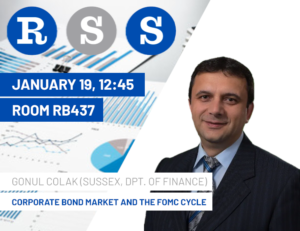Gonul Colak (University of Sussex) 19.1.2023

It is our pleasure that Dr. Gonul Colak (University of Sussex) will present on Thursdsay January 19, 2022 at 12:45 in room RB437 about his research on the topic “Corporate Bond Market and The FOMC Cycle“
BIO: Gonul Colak is a Professor of Accounting and Finance at University of Sussex Business School. He also holds a fractional professorship at Department of Finance at Hanken School of Economics. Recently, he was a visiting scholar at Stern School of Business in New York University, Fordham University, and Turkish Central Bank’s Istanbul School of Central Banking in Turkey. Previously he held academic positions at Florida State University and Wichita State University. Gonul Colak served as the chairman of the Graduate School of Finance (GSF) in Finland and was a member of the board in the Nordic Finance Network (NFN). He served as the director of the PhD program in finance at Hanken School of Economics. He is currently a member of the international advisory board of the Business School of Sebelas Maret University in Indonesia. He currently serves as an associate editor in Journal of Financial Stability. Gonul has publications in high-quality journals such as Review of Financial Studies, Journal of Financial Economics, Journal of Financial and Quantitative Analysis, Review of Accounting Studies, Journal of Financial Intermediation, and Journal of Corporate Finance. According to Scopus his published work has been cited around 530 times, some of which are in high impact journals.
ABSTRACT: The prescheduled FOMC meetings and the related information release (monetary policy uncertainty) form cyclical patterns in the corporate bond market. We analyze how corporate bond returns and bond market liquidity varies in each week of this cycle. The bond returns during the even weeks are relatively higher than the odd week returns (for two successive FOMC cycle weeks), which is consistent with the Cieslak et al.’s (2019) claim that Fed information production and decision-making being concentrated in the even weeks. The bond market liquidity does not display a biweekly pattern, and instead it increases in the weeks with close proximity to the FOMC announcement day and dries up in the middle of the cycle. When inter-dealer trades are removed, the liquidity pattern within the FOMC cycle reverses: the institutional traders (customers) seem to trade more often during the middle of the cycle when the monetary policy uncertainty is minimal. This suggests that institutional/customer trades, rather than the inter-dealer trades, are more affected by the monetary policy uncertainty associated with the proximity to the FOMC meeting. Another factor that shapes the corporate bond market patterns is the impact of unanticipated monetary policy shocks on weekly bond excess returns. The unanticipated changes in FFR and the policy news shock capturing forward guidance are both negatively affecting bond returns. This effect is not confined only to the week of the FOMC announcement and instead it shows certain persistence within the cycle.